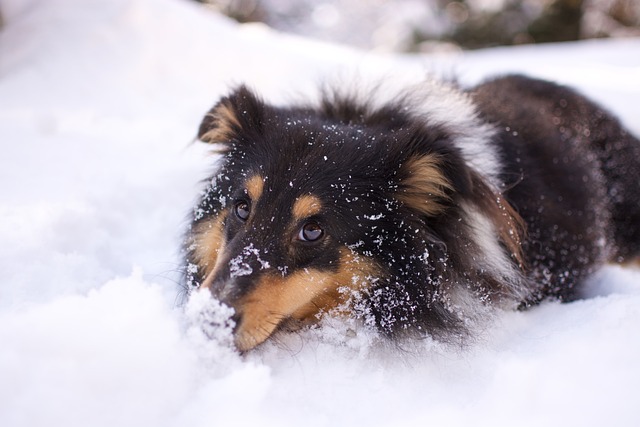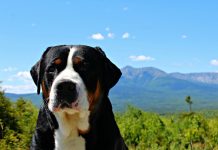History and Origins of the Shetland Sheepdog Breed

The Shetland Sheepdog, often affectionately called the “Sheltie,” is a small-to-medium-sized herding dog breed originating from the Shetland Islands of Scotland. Here’s an overview of the history and origins of the Shetland Sheepdog:
- Early Origins: The Shetland Sheepdog’s ancestors are believed to be small herding dogs brought to the Shetland Islands by Norse settlers. These dogs were likely crossed with other local breeds to develop the Shetland Sheepdog we know today.
- Herding Heritage: Shetland Sheepdogs were primarily used as herding and farm dogs on the rugged and remote Shetland Islands. They excelled in herding sheep and other livestock, thanks to their intelligence, agility, and strong work ethic.
- Miniature Collie Influence: During the 19th century, Shetland Sheepdogs were crossed with Collies brought to the islands, resulting in a smaller version of the Rough Collie. This contributed to the Sheltie’s distinctive appearance and gentle demeanor.
- Recognition and Development: The breed gained popularity in the late 1800s and early 1900s, especially after being exhibited in dog shows. The Shetland Sheepdog was recognized as a distinct breed by kennel clubs, including the American Kennel Club (AKC) in 1911.
- Modern Role: Today, Shetland Sheepdogs are beloved companion dogs and excel in various canine activities, including obedience, agility, and therapy work. They retain their herding instincts and make excellent family pets with their loyal and affectionate nature.
Physical Characteristics and Appearance of Shetland Sheepdogs
The Shetland Sheepdog is a distinctive and elegant breed with a beautiful coat and expressive eyes. Here are the key physical characteristics and appearance traits of Shetland Sheepdogs:
- Size: Shetland Sheepdogs are small-to-medium-sized dogs. Adult males typically stand between 13 to 16 inches (33 to 41 cm) at the shoulder, while females are slightly smaller, standing 13 to 15 inches (33 to 38 cm). They usually weigh between 14 to 27 pounds (6 to 12 kg).
- Build: They have a sturdy and balanced build, slightly longer than tall. The body is compact and muscular, suitable for agility and endurance.
- Coat: One of the most distinctive features of Shetland Sheepdogs is their dense double coat. The outer coat is long, straight, and harsh, while the undercoat is soft and dense. Their coat comes in various colors, including sable (ranging from golden to mahogany), blue merle, and tricolor (black, white, and tan).
- Head: Shetland Sheepdogs have a refined and expressive head with a tapered muzzle. The eyes are almond-shaped, dark, and expressive, conveying intelligence and alertness.
- Ears: Their ears are small, erect, and expressive, giving them a keen and attentive expression.
- Tail: The tail of a Shetland Sheepdog is long and bushy, carried low with a slight upward curve.
- Expression: Shelties are known for their sweet and gentle expression, often coupled with an alert and attentive demeanor.
- Gait: Shetland Sheepdogs move with effortless grace and agility. Their movement is smooth, flowing, and efficient.
- Overall Appearance: Shetland Sheepdogs exude elegance and intelligence, with a kind and friendly demeanor that makes them excellent companions.
Overall, the Shetland Sheepdog is a versatile and adaptable breed that excels both as a loving family companion and a skilled working dog. Their striking appearance and endearing personality have made them a popular choice for dog lovers worldwide. Proper grooming, exercise, and socialization are essential for keeping Shetland Sheepdogs happy and healthy companions.
Shetland Sheepdog Temperament and Personality Traits
- Intelligent: Shetland Sheepdogs are exceptionally smart dogs, ranking high in canine intelligence. They are quick learners and excel in obedience training and various canine sports.
- Loyal and Affectionate: Shelties form strong bonds with their families and are deeply loyal and devoted companions. They thrive on attention and affection from their owners.
- Energetic and Active: Despite their small size, Shetland Sheepdogs are energetic dogs with good stamina. They enjoy regular exercise and benefit from engaging activities to keep them mentally stimulated.
- Alert and Watchful: Due to their herding background, Shelties are naturally alert and attentive. They make excellent watchdogs and will alert their owners to any perceived threats.
- Sensitive: Shetland Sheepdogs are sensitive dogs that respond well to positive reinforcement training methods. They can be affected by harsh correction or raised voices, so gentle and patient training is recommended.
- Good with Children: Shelties are generally good with children and make excellent family pets. They are patient and gentle, although early socialization is important to ensure they are comfortable around kids.
- Reserved with Strangers: While they are not typically aggressive, Shetland Sheepdogs can be reserved or cautious around strangers. Proper socialization from an early age can help them develop confidence and friendliness towards new people.
- Herding Instincts: Shelties may exhibit herding behaviors such as nipping at heels or chasing moving objects. This instinct can be managed through training and providing appropriate outlets for their energy.
Training and Socialization Needs for Shetland Sheepdogs
- Early Socialization: Start socializing your Shetland Sheepdog puppy early to expose them to various people, animals, and environments. This helps them develop into well-adjusted adults and reduces the risk of shyness or fearfulness.
- Obedience Training: Shelties are eager to please and respond well to positive reinforcement training techniques. Teach them basic obedience commands such as sit, stay, come, and heel. Consistency and patience are key to successful training.
- Provide Mental Stimulation: Keep your Sheltie’s mind engaged with interactive toys, puzzle games, and training sessions. They enjoy learning new tricks and tasks, which helps prevent boredom and destructive behaviors.
- Regular Exercise: Shetland Sheepdogs have moderate exercise needs but benefit from daily walks, play sessions, and activities that allow them to burn off excess energy. A tired Sheltie is a well-behaved Sheltie.
- Avoid Boredom: Shelties are prone to boredom if left alone for long periods. Ensure they have plenty of mental and physical stimulation throughout the day, and consider interactive toys or puzzles to keep them entertained.
- Positive Reinforcement: Use positive reinforcement techniques such as treats, praise, and rewards to motivate and encourage desired behaviors. Avoid harsh training methods that can undermine their sensitive nature.
- Consistent Training: Be consistent with rules and boundaries to prevent confusion. Shetland Sheepdogs thrive in structured environments where expectations are clear.
- Patience and Time: Training a Shetland Sheepdog requires patience and time. They respond best to calm and gentle guidance, so avoid rushing or becoming frustrated during training sessions.
By meeting their training and socialization needs with patience, consistency, and positive reinforcement, you can raise a well-mannered and well-adjusted Shetland Sheepdog. They thrive on companionship and enjoy being an active part of family life, making them wonderful companions for households that appreciate their intelligence and affectionate nature.
Shetland Sheepdog Temperament and Personality Traits
- Intelligent: Shetland Sheepdogs are highly intelligent dogs, ranking among the smartest breeds. They are quick learners and excel in obedience training and agility activities.
- Loyal and Affectionate: Shelties are devoted and affectionate companions who form strong bonds with their families. They thrive on human companionship and enjoy being involved in family activities.
- Energetic and Active: Despite their small-to-medium size, Shetland Sheepdogs are energetic and require regular exercise to stay healthy and happy. They enjoy outdoor activities such as walks, hikes, and games of fetch.
- Alert and Watchful: Due to their herding background, Shelties are naturally alert and watchful. They make excellent watchdogs and will alert their owners to any unusual sights or sounds.
- Sensitive: Shetland Sheepdogs are sensitive dogs that respond well to positive reinforcement training methods. Harsh training techniques can cause them to become anxious or withdrawn.
- Good with Children: Shelties are usually good with children and make excellent family pets. They are patient and gentle, although early socialization is important to ensure they are comfortable around kids.
- Reserved with Strangers: While they are generally friendly, Shetland Sheepdogs can be reserved or cautious around strangers. Proper socialization from an early age helps them develop confidence and friendliness towards new people.
- Herding Instincts: Shelties may exhibit herding behaviors such as nipping at heels or chasing moving objects. This instinct can be managed through training and providing appropriate outlets for their energy.
Training and Socialization Needs for Shetland Sheepdogs

- Early Socialization: Start socializing your Sheltie puppy early to expose them to different people, animals, and environments. This helps prevent shyness or fearfulness later in life. Puppy classes and regular outings are beneficial.
- Obedience Training: Shetland Sheepdogs are eager to please and respond well to positive reinforcement training methods. Teach them basic obedience commands such as sit, stay, come, and heel. Consistency and patience are key to successful training.
- Provide Mental Stimulation: Keep your Sheltie’s mind engaged with interactive toys, puzzle games, and training sessions. They enjoy learning new tricks and tasks, which helps prevent boredom and destructive behaviors.
- Regular Exercise: Shetland Sheepdogs have moderate exercise needs but benefit from daily walks, play sessions, and activities that allow them to burn off excess energy. A fenced yard is ideal for off-leash play.
- Attention and Companionship: Shelties thrive on attention and companionship from their owners. They enjoy being involved in family life and may become anxious or develop behavioral issues if left alone for long periods.
- Positive Reinforcement: Use positive reinforcement techniques such as treats, praise, and rewards to motivate and encourage desired behaviors. Avoid harsh training methods that can undermine their sensitive nature.
- Consistent Training: Be consistent with rules and boundaries to prevent confusion. Shetland Sheepdogs thrive in structured environments where expectations are clear.
- Patience and Time: Training a Shetland Sheepdog requires patience and time. They respond best to calm and gentle guidance, so avoid rushing or becoming frustrated during training sessions.
By meeting their training and socialization needs with patience, consistency, and positive reinforcement, you can raise a well-mannered and well-adjusted Shetland Sheepdog. They are versatile and adaptable dogs that excel in various canine activities and make wonderful companions for active families who appreciate their intelligence and affectionate nature.
Shetland Sheepdog Variations and Breeding Practices
When it comes to Shetland Sheepdogs (Shelties), variations in the breed primarily revolve around coat color and markings, although they generally adhere closely to a breed standard in terms of size, structure, and temperament. Responsible breeding practices aim to preserve and enhance the desirable traits of Shetland Sheepdogs while minimizing the risk of inherited health conditions. Here’s an overview of variations in Shelties and key aspects of breeding practices:
Variations in Shetland Sheepdogs
- Coat Colors: Shetland Sheepdogs come in various coat colors, including:
- Sable: The most common color, ranging from golden to mahogany with varying degrees of shading.
- Tricolor: Black, white, and tan markings.
- Blue Merle: Mottled gray with black patches and tan points.
- Bi-Black: Black with minimal white markings.
- Bi-Blue: Blue-gray with minimal white markings.
- Markings: Shetland Sheepdogs may have white markings on the face, chest, legs, and tail tip. Some have a blaze (white stripe) on the forehead or a white collar around the neck.
- Size Variations: While Shelties generally fall within a standard size range, there can be slight variations in height and weight. Adult males typically stand between 13 to 16 inches at the shoulder, while females are slightly smaller, standing 13 to 15 inches.
- Temperament: While Shetland Sheepdogs share common temperament traits, such as intelligence, affection, and alertness, individual dogs may exhibit slight variations in personality. Some may be more outgoing and playful, while others may be more reserved or gentle.
Breeding Practices for Shetland Sheepdogs
Responsible breeding practices are essential for maintaining the health, temperament, and conformation of Shetland Sheepdogs. Here are key aspects of ethical breeding practices:
- Health Screening: Reputable breeders conduct health screenings on their breeding dogs to identify and minimize the risk of inherited health conditions. Tests may include hip and elbow evaluations, eye examinations (for conditions like Collie Eye Anomaly and Progressive Retinal Atrophy), and genetic testing for known genetic disorders.
- Breed Standard Adherence: Ethical breeders adhere to the official breed standard set by kennel clubs like the American Kennel Club (AKC) or the Fédération Cynologique Internationale (FCI). This includes guidelines for appearance, size, coat color, and temperament.
- Genetic Diversity: Responsible breeders prioritize genetic diversity within the breed to prevent inbreeding and maintain overall health and vitality. They carefully select breeding pairs based on complementing traits and genetic compatibility.
- Temperament and Behavior: Breeders consider temperament and behavior when selecting breeding dogs to ensure the continuation of desirable traits such as intelligence, trainability, and sociability.
- Ethical Standards: Reputable breeders prioritize the welfare of their dogs over financial gain. They do not engage in practices such as puppy mills or indiscriminate breeding.
- Lifetime Commitment: Ethical breeders are committed to the well-being of their dogs throughout their lives. They provide support to puppy buyers, offer health guarantees, and remain available for advice and guidance.
By following responsible breeding practices and understanding the variations within the breed, breeders contribute to the preservation and improvement of the Shetland Sheepdog breed. Prospective puppy buyers should seek out reputable breeders who demonstrate a commitment to the breed’s health, temperament, and overall welfare.
50 Best Names with Meanings for Shetland Sheepdogs
Naming your Shetland Sheepdog is a fun and meaningful part of welcoming them into your family. Here’s a list of 50 great names along with their meanings that could be perfect for your Sheltie:
- Copper – Refers to the reddish-brown color, resembling the sable coat of many Shelties.
- Willow – A graceful and slender tree, suitable for the elegant appearance of a Shetland Sheepdog.
- Finn – Means “fair” or “white” in Gaelic, suitable for Shelties with predominantly white markings.
- Rosie – Short for Rose, symbolizing beauty and grace.
- Rusty – Reflects the reddish or sable color of the Sheltie’s coat.
- Skye – Named after the beautiful Scottish Isle of Skye, close to the Shetland Islands.
- Ollie – Short for Oliver, meaning “peaceful” or “olive tree.”
- Sasha – Means “defender of mankind,” fitting for a loyal and protective Sheltie.
- Misty – Refers to a soft, ethereal appearance, similar to the Sheltie’s fluffy coat.
- Leo – Short for Leonardo, meaning “brave lion.”
- Hazel – Represents the hazel color, often seen in the eyes of Shelties.
- Luna – Means “moon,” reflecting the Sheltie’s graceful and luminous presence.
- Cody – Means “helpful” or “pillow,” symbolizing comfort and companionship.
- Ivy – A symbol of faithfulness and friendship.
- Max – Short for Maximus, meaning “greatest” or “most excellent.”
- Sadie – Means “princess” or “noblewoman.”
- Bailey – Refers to a fortress or protective wall.
- Ginger – Named after the warm and spicy ginger color.
- Scout – Represents a vigilant and observant nature.
- Milo – Means “merciful” or “soldier,” fitting for a devoted Sheltie.
- Zoe – Means “life” or “vitality.”
- Riley – Means “courageous” or “valiant.”
- Penny – Symbolizes wealth and good fortune.
- Toby – Means “God is good,” reflecting blessings and gratitude.
- Stella – Means “star,” symbolizing radiance and beauty.
- Sammy – Short for Samuel, meaning “heard of God” or “name of God.”
- Mocha – Named after the rich and dark coffee color.
- Willow – A graceful and slender tree, suitable for the elegant appearance of a Shetland Sheepdog.
- Buddy – Represents a loyal and dependable companion.
- Daisy – Represents innocence and purity.
- Charlie – Means “free man” or “strong.”
- Ruby – Represents passion and vitality.
- Misty – Refers to a soft, ethereal appearance, similar to the Sheltie’s fluffy coat.
- Bailey – Refers to a fortress or protective wall.
- Holly – Named after the holly tree, symbolizing protection and goodwill.
- Loki – Named after the mischievous Norse god, fitting for a playful Sheltie.
- Willow – A graceful and slender tree, suitable for the elegant appearance of a Shetland Sheepdog.
- Molly – Means “star of the sea,” representing strength and beauty.
- Rocky – Represents strength and resilience.
- Sandy – Refers to the color of sand, symbolizing warmth and comfort.
- Bella – Means “beautiful,” reflecting the Sheltie’s lovely appearance.
- Shadow – Represents a mysterious and protective nature.
- Rusty – Reflects the reddish or sable color of the Sheltie’s coat.
- Lucky – Symbolizes good fortune and blessings.
- Tucker – Means “fabric pleater” or “cloth-folder.”
- Piper – Refers to a musical performer, fitting for a Sheltie’s lively spirit.
- Gizmo – Represents a small, clever gadget or device.
- Annie – Means “grace” or “favor,” reflecting the Sheltie’s gentle nature.
- Teddy – Named after a beloved teddy bear, symbolizing comfort and warmth.
- Lexi – Short for Alexis, meaning “defender” or “helper.”

Choose a name that resonates with you and captures the essence of your Shetland Sheepdog’s personality and appearance. Whether you prefer a classic name or something unique, your Sheltie will appreciate the special bond you share through their name.






























